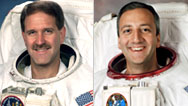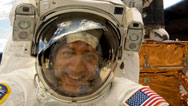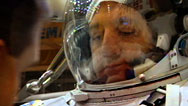Saving Hubble
- Posted 07.09.08
- NOVA scienceNOW
(This program is no longer available for online streaming.) Hubble is in trouble—the Hubble Space Telescope, that is. The hugely productive scientific instrument that has generated so many stunning images of the universe is due for a service call—its last. Host Neil deGrasse Tyson travels to the NASA Goddard Space Flight Center, where he is given special access to the astronauts who are training for one of the most complex missions ever attempted.
Transcript
SAVING HUBBLE
PBS Airdate: July 9, 2008
NEIL DeGRASSE TYSON: Hi, I'm Neil deGrasse Tyson, your host of NOVA scienceNOW.
Here's a question I get asked a lot: "How many astrophysicists does it take to change a light bulb?" Well, depends on the circumstances. For instance, what if the light bulb is on a priceless crystal chandelier? And you had to change the light bulb wearing boxing gloves? And what if that chandelier is way up high and you have to stand on the top of a tall, rickety ladder to reach it?
Whoa!
What if this intricate job must be performed in space?
These are just the sorts of challenges, all together, at once, facing astronauts on an important and risky mission. A team of specialists prepares for emergency surgery, a risky procedure that will cost millions.
Luckily, this patient is a celebrity, with an excellent health plan—courtesy of the U.S. government—the Hubble Space Telescope.
The Hubble is probably the best-known scientific instrument ever. Since 1990, it's brought us unprecedented views of the universe and revolutionized astrophysics.
MATT MOUNTAIN: Twenty years ago, before the Hubble flew, we didn't know how big the universe was or how old it was. Now we do. We didn't know that black holes really existed. We now know that black holes are everywhere. And the Hubble Telescope was the first telescope to actually examine the composition of a world around another star. Without the Hubble, none of those things would have happened.
NEIL DeGRASSE TYSON: But now, Hubble is in trouble. It's dying, and half its instruments, including the camera that took these pictures, are already dead. The only hope to save Hubble is a shuttle mission, scheduled for this fall. It won't be the first one. Since 1990, astronauts have been there four times, installing new mirrors, doing maintenance and replacing scientific instruments.
A fifth trip was in the works, but the 2003 Columbia disaster caused NASA to cancel the mission as too risky. If anything were to go wrong, rescuing the astronauts would be extremely difficult.
Nonetheless, after numerous appeals from scientists, astronauts and especially the public, in late 2006, NASA decided to try one more Hubble mission.
MATT MOUNTAIN: This mission is one of the most complex that they've ever undertaken. And the risk of dying is one in 70. I mean, it's incredible; these are very brave people.
NEIL DeGRASSE TYSON: Two teams of astronaut spacewalkers will do the work. John Grunsfeld leads one team. He's been to Hubble twice before.
JOHN MACE GRUNSFELD (NASA Astronaut): The Hubble was designed to be serviced by people, to take things out, put things in, turn bolts, keep it running.
NEIL DeGRASSE TYSON: Leading the second team is Mike Massimino. He worked with John Grunsfeld on Hubble, in 2002.
MICHAEL MASSIMINO (NASA Astronaut): If we can fix Hubble, with its new capabilities, it's going to make some great discoveries.
NEIL DeGRASSE TYSON: There's lots to do: replace batteries, install a brand new camera, swap out gyros, remove old optics, install a new spectrograph, and more.
MIKE MASSIMINO: Generally, what we do is we come up with a whole replacement for an instrument or for a piece of equipment. And even if something little is wrong with it, you don't mess with it, usually. You just pull it out and put the whole new one in.
NEIL DeGRASSE TYSON: This mission is different. There's a broken instrument they can't replace: the Advanced Camera for Surveys, or A.C.S., which died just last year.
Ever since it was installed, in 2002, A.C.S. has been the workhorse camera on Hubble, taking 70 percent of its pictures, detecting some of the most distant objects in the universe and helping to solve some of the greatest mysteries in modern astrophysics. With no replacement available for A.C.S., astronauts will try something they've never done before: actual repairs in space.
CHUCK SHAW (Director, Hubble Servicing Mission): Instead of just replacing or adding components, we're actually going inside.
CHRISTY HANSEN (Astronaut Trainer): We're changing an electronics card out. We've never done that on orbit.
CHUCK SHAW: It's more like neurosurgery.
MIKE MASSIMINO: At first it sounded like this would be impossible.
NEIL DeGRASSE TYSON: To find out how they plan to do this "mission impossible," I went to Goddard Space Flight Center, in Maryland. Deputy Program Manager Mike Weiss took me through the world's largest cleanroom. Every tool, part and new instrument going to Hubble is kept here.
They do some serious air filtering in this place.
You're telling me this entire wall is nothing but HEPA filters?
MIKE WEISS: That's right.
NEIL DeGRASSE TYSON: Why?
MIKE WEISS: Well, when you're in a hospital operating room, the thing that's dangerous to a patient is germs. The thing that's dangerous to Hubble is contamination.
NEIL DeGRASSE TYSON: Dust, dandruff, even stray skin cells on Hubble's optics would blind some of the pixels, putting a spot on all future Hubble photos.
In the heart of this super clean operating room, is a life-sized mockup of the patient: the part of Hubble containing the instruments. Deep inside is A.C.S., the vital organ that's failed. It might look like a refrigerator, but this big black box is actually a precision digital camera.
Just like any digital camera, A.C.S. runs off electronics. And that's what's died, the power supply. To fix it, 32 tiny screws have to be removed, then a cover, then circuit boards have to come out.
Okay, so this would be the offending power supply board. Even though right now it's just a smooth surface, I would see printed circuitry here and...
MIKE WEISS: Absolutely.
NEIL DeGRASSE TYSON: ...components?
MIKE WEISS: Right, absolutely. And they're going to pull all four of these boards out.
NEIL DeGRASSE TYSON: So this seems easy enough. Where's the challenge?
MIKE WEISS: The challenge is it was never designed to be pulled out like that, with an astronaut wearing a glove, and it could compromise the glove. It could have sharp edges.
NEIL DeGRASSE TYSON: "Compromise the glove" is euphemism for me losing the pressurization of my suit and dying?
MIKE WEISS: Ultimately.
NEIL DeGRASSE TYSON: Danger is just one challenge. Working while weightless is quite another. Things like tools and loose screws will float. And if you're not strapped down, when you try to turn a screw, your body turns instead.
So how do they learn to do this work?
MIKE MASSIMINO: It's hard. You know, if you're going to play a baseball game you can go out to the field and take batting practice. But to go to space, you show up for the World Series without practicing on the field, so to speak, so you've got to get all your practice in other places.
NEIL DeGRASSE TYSON: The best place to practice spacewalking is underwater, at the Neutral Buoyancy Laboratory in Houston.
MIKE MASSIMINO: The Neutral Buoyancy Lab is a fancy name for a big giant pool. You can fit a whole space shuttle in there, plus a whole space station. It's huge. They try to get us neutrally buoyant, and that enables us to practice our spacewalking. We can egress the space shuttle and move along the handrails and work with the telescope. And it's very close to learning the body positioning and the skills you need to spacewalk.
NEIL DeGRASSE TYSON: It might look easy. But doing anything in a stiff pressurized suit is tough, grueling work.
MIKE MASSIMINO: You can get tired. You're in this suit for about eight hours. There's no food in there with you, so you have to have a good breakfast. You do have a drink bag so you can drink water while you're doing this, but you really need to be in the best shape you can be in.
NEIL DeGRASSE TYSON: It's roughest on the hands; in stiff gloves they take quite a beating.
JOHN GRUNSFELD: We've had astronauts losing fingernails, you know? Black and blue, and the fingernails fall off after a few days. Fact of the matter is, the glove rules.
NEIL DeGRASSE TYSON: So just imagine, the glove rules and you're trying to fix A.C.S. Well, here's the instructions: first, remove 32 screws from power supply cover; don't lose these. Next, pull off cover, exposing circuit boards. Remove four circuit boards; caution: these may be sharp. Insert new circuit board assembly, replace cover. Batteries not included.
Oh, and by the way, those 32 tiny screws? If just one floats into Hubble, it could trash the telescope forever.
So how are they going to get those screws out safely? With a special contraption designed just for this mission: the Fastener Capture Plate.
JOHN GRUNSFELD: It's basically a panel that is made out of a clear plastic and has holes in that you can put a screwdriver through.
MIKE MASSIMINO: But small enough so that nothing will come out.
JOHN GRUNSFELD: As a result, we can remove all those screws. They'll float around, but we won't lose any. And then we can take the cover plate off.
NEIL DeGRASSE TYSON: To get a feel for what it's like using the Fastener Capture Plate, I decided to try it myself.
In space, 32 screws have to come out. I figured I'd try two. So I've got my miner's light into number 17. Steady. There we go. I'm in. We are succeeding, I think. I am not succeeding. And I can't imagine doing this in a spacesuit.
Doing it in a spacesuit is exactly what John Grunsfeld has to do, in space and practicing it in the pool. After making his way over to the Hubble mockup, the first step is get inside, to the dark, nearly inaccessible corner where A.C.S. is located.
JOHN GRUNSFELD: Okay, I have the Fastener Capture Plate; I've got three knobs. Bueno, what are they called?
MIKE GOOD: The three hard docks?
NEIL DeGRASSE TYSON: Up in the control room, engineers and other astronauts monitor the checklist on which Grunsfeld's every move is scripted against a timeline.
MIKE GOOD: Okay, so you've engaged the three latches?
JOHN GRUNSFELD: Affirmative.
MIKE GOOD: And then I've got some other tools for you to pick up. Let me know when you're ready.
NEIL DeGRASSE TYSON: Removing the screws would be challenging, even if they were out in the open. But where they are, they're almost impossible to reach.
JOHN GRUNSFELD: Because of the bulk of the spacesuit, I can't get in far enough really to see them straight on. So I'm going to be kind of working around the corner with the screwdriver.
Number 3 is hard to see.
MIKE GOOD: Copy, three is difficult to see.
JOHN GRUNSFELD: Yeah.
MIKE GOOD: Okay. And was there a problem with the Fastener Capture Plate sticking on there?
JOHN GRUNSFELD: What's happening is the reflection of the tool on the plastic is making it so I can't see if I'm in the screw head. It's just...it looks like the teeth are rounded out.
MIKE GOOD: So the screw is stripped?
JOHN GRUNSFELD: Yeah.
MIKE GOOD: Okay.
NEIL DeGRASSE TYSON: A stripped screw—in space, this would be a huge problem, possibly ending the A.C.S. repair.
After six hours, the practice spacewalk is over.
JOHN GRUNSFELD: It went miserably. We had all kinds of problems. The little crosses in the Philips head, in the torque set, stripped out. And that's one of those disaster scenarios where then we're not going to get the cover plate off. So my confidence in this task is probably at its all-time low right now. But that's the way it goes.
NEIL DeGRASSE TYSON: The Hubble servicing mission is scheduled for this fall. Even now, they're still working to perfect those spacewalks. But no amount of practice will make it a sure thing or a safe thing.
JOHN GRUNSFELD: You got four and a half million pounds of explosive fuel; it would be foolish not to think about the risks. So I think each individual astronaut has to ask themselves the question: "Is this risk worth it?"
Going to upgrade and repair the Hubble Space Telescope, to serve science, to enable great science and to enable great future discoveries, that's something that I believe is worth risking my life for.
Credits
Saving Hubble
- Edited by
- Doug Quade
- Written, Produced and Directed by
- Rushmore DeNooyer
NOVA scienceNOW
- Executive Producer
- Samuel Fine
- Executive Editor
- Neil deGrasse Tyson
- Senior Series Producer
- Vincent Liota
- Supervising Producers
- Stephen Sweigart
Joey David - Editorial Producer
- Julia Cort
- Development Producer
- Vinita Mehta
- Senior Editor
- David Chmura
- Online Editor
- Laura Raimondo
- Series Production Assistant
- Fran Laks
- Assistant Editors
- Susan Perla
Tung-Jen (Sunny) Chiang - Compositors
- Brian Edgerton
Yunsik Noh
Tristian Goik - Music
- Rob Morsberger
- NOVA scienceNOW Series Animation
- Edgeworx
- Associate Producers
- Melanie Cunningham
Jeff Marion
Steven Reich - Camera
- Chad Baron
Joseph Brunette
Mark Carroll
Joseph Friedman
Sean Glenn
Mark Gunning
Jerry Hattan
Edward Marritz
Michael D. McClare - Sound Recordists
- Chad Baron
Tom Eichler
Dennis Hrbek
Charlie Maccarone
Janice Mahan
Mark Mandler
Pete Nenortas
JR Rodriguez
Paul Rusnak
Dennis Sprankel
Robert Sullivan
John van der Does - Sound Mix
- David Chmura
- Animation
- Brian Edgerton
Sputnik Animation
James LaPlante - Production Assistants
- Daniel Sites
Elizabeth Stachow
Bobby Tucker - For Lone Wolf Documentary Group
- Executive Producer
- Kirk Wolfinger
- Production Manager
- Donna Huttemann
- Archival Material
- American Broadcasting Companies
BBC
Larry Burrows Estate
Janice Carr
Wade B. Clark Jr.
Corbis
Friedman Archives
ITN
Utako Kikutani
NASA
National Geographic
NewspaperArchive.Com
NIAID/RML
Streamline Films
Adam Zoghlin, Timelapse.com - Special Thanks
- Comunidad Inti Wara Yassi
Tim Endy, MD
Goddard Space Flight Center
Gerard Irzyk, PhD, 454 Life Sciences
Meena Hartenstein
Lance Corporal Tim Lang
Nicholas Ornston, PhD
Penn State University
The Crew of SM-4
Walter Reed Army Medical Center
Eric Sargis
Michael Snyder, PhD
The Snyder Lab, Yale University
Arjun Srinivasan, MD
University of Florida
Bob and Lee Woodruff
Glenn Wortmann, MD
Yale University - Neil deGrasse Tyson
- is director of the Hayden Planetarium in the Rose Center for Earth and Space at the American Museum of Natural History.
- NOVA scienceNOW Consortium Stations
- Nebraska Educational Telecommunications, NET
Public Broadcasting for Northern California, KQED
Twin Cities Public Television, TPT
Wisconsin Public Television, WPT - NOVA Series Graphics
- yU + co.
- NOVA Theme Music
- Walter Werzowa
John Luker
Musikvergnuegen, Inc. - Additional NOVA Theme Music
-
Ray Loring
Rob Morsberger - Post Production Online Editor
- Spencer Gentry
- Closed Captioning
- The Caption Center
- Publicity
-
Carole McFall
Eileen Campion
Lindsay de la Rigaudiere
Victoria Louie
Kate Becker - Senior Researcher
- Gaia Remerowski
- Production Coordinator
- Linda Callahan
- Paralegals
- Raphael Nemes
Sarah Erlandson - Talent Relations
- Scott Kardel, Esq.
Janice Flood - Legal Counsel
- Susan Rosen
- Post Production Assistant
- Darcy Forlenza
- Associate Producer, Post Production
- Patrick Carey
- Post Production Supervisor
- Regina O'Toole
- Post Production Editors
- Rebecca Nieto
Alex Kreuter - Post Production Manager
- Nathan Gunner
- Compliance Manager
- Linzy Emery
- Business Manager
- Joseph P. Tracy
- Producers, Special Projects
- Lisa Mirowitz
David Condon - Coordinating Producer
- Laurie Cahalane
- Senior Science Editor
- Evan Hadingham
- Senior Series Producer
- Melanie Wallace
- Managing Director
- Alan Ritsko
- Senior Executive Producer
- Paula S. Apsell
This material is based upon work supported by the National Science Foundation under Grant No. 0638931. Any opinions, findings, and conclusions or recommendations expressed in this material are those of the author(s) and do not necessarily reflect the views of the National Science Foundation.
NOVA scienceNOW is a trademark of the WGBH Educational Foundation
NOVA scienceNOW is produced for WGBH/Boston by NOVA
© 2008 WGBH Educational Foundation
All rights reserved
- Image credit: (astronaut in space) Courtesy NASA
Participants
- John Mace Grunsfeld
- NASA Astronaut www.jsc.nasa.gov/Bios/htmlbios/grunsfel.html
- Christy Hansen
- Astronaut Trainer
- Michael Massimino
- NASA Astronaut www.jsc.nasa.gov/Bios/htmlbios/massimin.html
- Matt Mountain
- AURA
- Chuck Shaw
- Director, Hubble Servicing Mission
Related Links
-

Saving Hubble: Expert Q&A
The crew of the upcoming STS-125 Space Shuttle mission to repair the Hubble answers viewer questions.
-

Saving Hubble Update
Two teams of spacewalkers take on unprecedented challenges to repair the world's most beloved telescope.
-

How Hubble Sees
Assemble the famous image of the Eagle Nebula from the Hubble Space Telescope's raw data.
-

Hands on Hubble
Astronomer-astronaut John Grunsfeld explains in this podcast why fixing the Hubble is all about the gloves.
-

Life of an Astronaut
In this video, veteran spacewalker Mike Massimino talks about the challenges of training to work in space.



